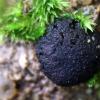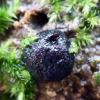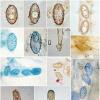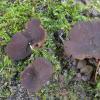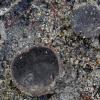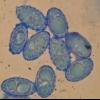
21-12-2025 09:32
Hello.A tiny ascomycete found embedded in wood in

21-12-2025 21:32
Pol DebaenstHello, Garden, Burgweg 19, Veurne, BelgiumOn 10/1

22-12-2025 23:38
Patrice TANCHAUDBonsoir, récolte sur un mur en pierre, apothéci

22-12-2025 00:47
Patrice TANCHAUDBonsoir, récolte à proximité du milieu dunaire

21-12-2025 21:40
Isabelle CharissouBonjour, j'aimerais connaitre les références de

20-12-2025 23:08
Patrice TANCHAUDBonsoir, récolte sur sol sablonneux dans l'arri�
Black Peziza
Nedim Jukic,
04-09-2016 15:34
 Hi,
Hi,I wil copy/paste some data from other topic, sorry once more for the incovenience.
Found one discoid apothecia (0,4 cm diam.) on wet and sprinkled riverbank, covered in moss in Medittereneaen part of Bosnia and Herzegovina (28.08.2016., just above 110 m)
Ascospores brownish: 17.5 - 19.7 x 9.2 - 10.7 µm
Paraphyses up to 10 µm in the apex, on average 6-9 µm wide, usually emerged in brown pigment.
I`m not sure whether or not this could fit P.limnaea. Distincly brown spores, and highly pigmented paraphyses and area around are some of the uncertainties. On the other hand ecology/elevation of P. alaskana is much more different (not inculding record from Israel).
What do you think? Appreciate any comments.
Regards,
Nicolas VAN VOOREN,
04-09-2016 16:02

Re : Black Peziza
Well, P. alaskana doesn't have "echinulate" ascospores like some spores in your collections... P. limnaea is distinctly cupulate. P. depressa can be so dark at the end and has similar ascospores but without short crests. P. atrospora has also similar spores but it is a cupulate species with reddish tinges.
So it's hard to give a correct determination based on one old specimen.
So it's hard to give a correct determination based on one old specimen.
Nicolas VAN VOOREN,
04-09-2016 17:13

Re : Black Peziza
I found in my notes a collection that fits well with yours. This cup-fungus was collected last year, on a riverbank at 1670 m alt. The species is not distinctly cupulate, dark brown to blackish at the end, measuring 7-20 mm in diam. The flesh was milky (but not visible on oldest specimens). A brown external pigment is also present at the top of the paraphyses. The ascospores measure 15-17 (18) × 9-10 µm (a bit smaller than yours), have the same guttulation, and a very similar ornamentation.
Maybe the same fungus, but I have no name. The close species seems to be P. badiofusca.
Maybe the same fungus, but I have no name. The close species seems to be P. badiofusca.
Nedim Jukic,
04-09-2016 20:10

Re : Black Peziza
Thanks a lot for your comments Nicolas.
That could be the same one.
It is same "mossy" riverbank habitat, but significatly different elevation.
I`ve also noted a presence of small pseudohairs at the margin, up to 75 µm in lenght, and 9 µm wide, elongated from ectal excipulum cells.
Nedim
That could be the same one.
It is same "mossy" riverbank habitat, but significatly different elevation.
I`ve also noted a presence of small pseudohairs at the margin, up to 75 µm in lenght, and 9 µm wide, elongated from ectal excipulum cells.
Nedim
